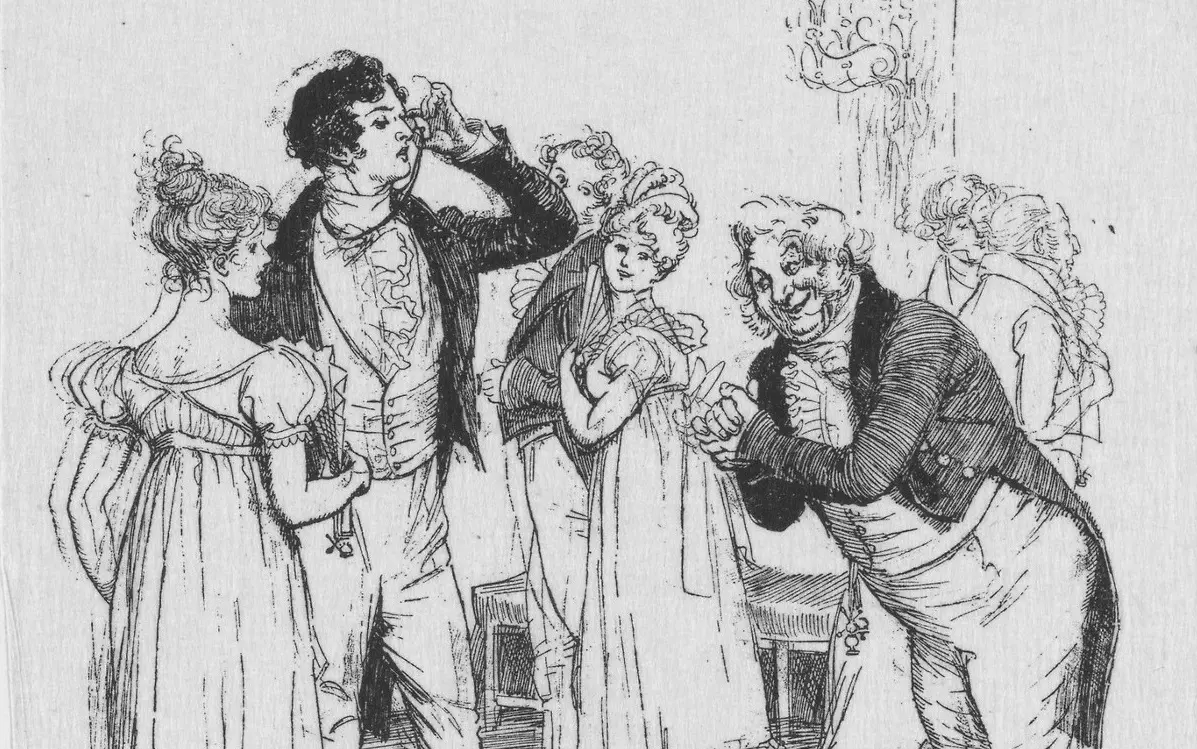In this series, we’re excerpting summaries Ken Boa has produced over the years on classic works of literature. See the first post for a list of 16 classics every Christian should know.
[lead]While not an overtly Christian novel, Pride and Prejudice evinces the moral obligations that flow from a Christian worldview.[/lead] The book—typically considered the finest of Jane Austen’s six novels—brilliantly portrays the need to develop mutual respect, sympathy, and concern; to allow pain and misunderstanding to forge growing character; and to learn that [ictt-tweet-inline]the quality of our lives directly relates to the quality of our commitments and esteem for others[/ictt-tweet-inline].
Austen: “Thoroughly Religious & Devout”
Jane Austen lived from 1775 to 1817. Her parents, George and Cassandra, were members of prominent gentry families, and her father served as an Anglican rector. One of eight children (including six brothers), Jane grew up attending church regularly. She initially accepted but later withdrew her acceptance to the one marriage proposal she ever received—deciding that marriage without affection would be a serious mistake.
Austen’s literary career began to flourish in Chawton (in Hampshire, England), where she moved with her family in 1809. Her best-known novels were published in rapid succession over the next eight years. Though Pride and Prejudice was published in 1813, Austen finished the first manuscript of the book much earlier—in 1797—under a different title: First Impressions.[note]Her original title was scratched due to another novel and play of the same name in circulation at that time. The final title corresponds to a common expression of her time.[/note]
In 1816, Austen began to suffer from a chronic illness, possibly Addison’s disease or Hodgkin’s lymphoma. Her condition gradually deteriorated until she died in 1817 at age 41.
In a biographical sketch of his sister, Jane’s brother Henry added this note:
One trait only remains to be touched on; it makes all others unimportant. She was thoroughly religious and devout, fearful of giving offense to God, and incapable of feeling it towards any fellow creature. On serious subjects she was well-instructed, both by reading and meditation, and her opinions accorded strictly with those of our established church.
She was thoroughly religious and devout, fearful of giving offense to God, and incapable of feeling it towards any fellow creature.
—Henry Austen, writing on his sister Jane
A letter Jane wrote in 1814 to friend Fannie Knight seemed to affirm her brother’s assessments of her religious beliefs. In it, Jane confided, “I am by no means convinced that we ought not all of us to be evangelicals and I am at least persuaded that they who are so from reason and feeling must be happiest and safest.”
Austen’s books did not enjoy a wide readership until after her nephew wrote a memoir about her in 1860. By the early 1900s, her novels became a subject for academic study. Her narrative style and depth led to her eventual recognition as one of the greatest writers of English fiction and one of the greatest female novelists of all time.
Plot: A Romantic Comedy
Pride and Prejudice is a novel of the mind and heart containing a minimum of plot action. (Twenty-first-century readers may find the novel slow or even tedious as a result.) Instead, the movements consist of seeing and saying, thinking and feeling, wondering and assessing, hoping and fearing, and conjecturing and interpreting.
Austen’s novel is set in the English countryside near a village roughly 30 miles from London. It introduces the Bennet family of Longbourn and the five unmarried Bennet daughters (including Elizabeth, the book’s protagonist, and the eldest, Jane). Mrs. Bennet is intent on seeing her daughters married off to wealthy men. The satirical opening sentence (together with the conversation that follows between Mrs. Bennet and her indifferent, sarcastic husband) sets the tone and theme of the entire novel: “It is a truth universally acknowledged, that a single man in possession of a good fortune must be in want of a wife.”
Throughout the book, Austen uses both positive and negative examples to level harsh social criticisms—including the idea that money, not love, motivated many unsuitable marriages in her time. (One of these marriages, we quickly learn, is the Bennets’.)
For a full summary of the plot and more commentary on the novel, get Ken Boa’s A Taste of the Classics, Volume 4. [vector_icon icon=”fas fa-arrow-alt-circle-right”]
Themes
Love & Respect in Marriage
At one point, Austen lets us know that, although Mr. Bennet has remained physically faithful to his wife, his contempt has infected their daughters as he has modeled disrespect and disregard for his wife in front of them. Elizabeth says she feels “strongly . . . the disadvantages that must attend the children of so unsuitable a marriage.” Here, Austen alludes to two of her central themes:
- Marriage depends on mutual respect; and
- Marriage affects society.
Whereas pre-Victorian society tended to degrade marriage into a mere social institution designed to provide for personal comfort, status, and security, Austen used her novel to reassert its fundamental importance as the cornerstone of the family and society. Through her characters, she shows the benefits, personal and societal, of marriages based on mutual respect and the detriments of marriages motivated by superficial concerns.
Austen used her novel to reassert the fundamental importance of marriage as the cornerstone of the family and society.
The dysfunction of the Bennet family is at the center of the book’s themes; English literature scholar Alistair Duckworth summarized it this way:
Mr. Bennet’s somewhat cynical irony, his wife’s fixed concern to marry off her daughters, Jane’s indiscriminate benevolence, Mary’s pedantry, and the youngest sister’s love of the military are all evident as too are Elizabeth’s perceptiveness and special position. Elizabeth and her older sister, Jane, are allies in this novel. Their powers of conversation are considerable. They could describe an entertainment with accuracy, relate an anecdote with humor, and laugh at their acquaintance with spirit. The third sister, Mary, is socially inept. Although she has acquired knowledge and some accomplishments, she lacks discernment and compassion. The two youngest daughters, Kitty and Lydia, both lack education and sense. They seek attention, entertainment, and excitement. Lydia in particular contrasts the oldest Bennet daughters, for she is characterized by a complete lack of restraint or concern for the well-being of anyone but herself.
Various other characters offer us glimpses into the English nobility and their attitudes, particularly toward marriage. Indeed, the Gardners provide one of the book’s only examples[note]The other example is the eventual relationship between Darcy and Elizabeth, once they’ve matured.[/note] of a healthy marriage, based on mutual love and respect.
The Gardners’ Example of Respect
The Gardners enjoy each other’s company, cooperate to raise happy and sensible children, and bring out the best in each other and those around them. The couple involve themselves in the lives of their beloved nieces, providing the guidance and diplomacy that the girls’ own parents fail to provide.
Austen emphasizes respect as the central pillar of marriage in one particular scene between Elizabeth and her father. Darcy has since requested permission to marry her, and Mr. Bennet calls Elizabeth in to question her about her feelings on the issue. He earnestly asks, “Lizzy, what are you doing? Are you out of your senses, to be accepting this man? Have not you always hated him? … He is rich, to be sure, and you may have more fine clothes and fine carriages than Jane. But will they make you happy?”
Mr. Bennet goes on to make an impassioned plea: “I know that you could be neither happy nor respectable, unless you truly esteemed your husband, unless you looked up to him as a superior. Your lively talents would place you in the greatest danger in an unequal marriage. You could scarcely escape discredit and misery. My child, let me not have the grief of seeing you unable to respect your partner in life. You know not what you are about” (italics original). This conversation reveals the heart of a man who has learned much from his errors and suffering. His own unequal marriage and inability to respect his spouse have led him to use his intellect destructively—to sarcastically tear down rather than build up his life partner. He recognizes the danger for his beloved daughter and seeks to make her aware of the danger she potentially faces.
Although the reader understands that Elizabeth is not making a marital mistake, Austen uses this scene to reiterate her central theme: respect is the basis of all healthy relationships, and pride and prejudice develop when respect is lacking.
Respect is the basis of all healthy relationships, and pride and prejudice develop when respect is lacking.
In a letter of gratitude from Elizabeth to her Aunt Gardner, Austen includes one final image to convey the value of true love and mutual respect when Elizabeth writes, “I am the happiest creature in the world. … I am happier even than Jane; she only smiles, I laugh.” While unequal marriages such as Mr. Bennet’s condemn others to a lifetime of only laughing at their spouses, Elizabeth anticipates a life of love and growth as she laughs with her spouse—a significant contrast.
Check out Ken Boa’s full list of recommended books and reading. [vector_icon icon=”fas fa-arrow-alt-circle-right” color=”#dd9933″]
Pride & Prejudice
In addition to addressing the basis for a happy, healthy marriage relationship, the novel develops other themes, including the title traits of pride and prejudice.
While many characters exhibit facets of these vices, Elizabeth and Darcy clearly learn the most about their vulnerability in these areas. At one point in the book, Elizabeth’s pride in her own abilities is abased as she discovers that her assessments of Darcy, as well as of another character (George Wickham), have been entirely wrong. She realizes that she has been blind, partial, prejudiced, and absurd: “How despicably have I acted,” she cried. “I, who have prided myself in discernment; I, who have valued myself and my abilities, who has often disdained the candor of my sister and gratified my vanity in useless or blamable distrust; how humiliating is this discovery.” Although this is one of the most painful lessons of her young life, it proves a pivotal point of growth in her character development.
Darcy, for his part, has undergone a process of self-scrutiny by the end of the novel as well. He says to Elizabeth, “What did you say of me that I did not deserve? For though your accusations were ill-founded, formed on mistaken premises, my behavior to you at the time had merited the severest reproof.” Thus, Austen makes clear that her characters have undergone a maturing process through suffering and self-examination.
While Darcy and Elizabeth are somewhat aware of their character weaknesses, the same cannot be said of all characters in the novel—perhaps most notably, Mr. William Collins (the most comical character) and Lady Catherine de Bourg (whose greatest delight is found in reminding those around her of their social inferiority).
Christian & Moral Themes
In 1821, Richard Whately commented on Austen’s careful and subtle use of Christian and moral themes. He wrote, “Miss Austen has the merit, in our judgment, most essential to being evidently a Christian writer; a merit that is much enhanced both on the score of good taste and of practical utility, by her religion being not at all obtrusive.” Whately went on to write that
the moral lessons, also, of this lady’s novels, though clearly and impressively conveyed, are not offensively put forward, but spring incidentally from the circumstances of the story. They are not forced upon the reader, but he is left to collect them, though without any difficulty, for himself. Hers is that unpretending kind of instruction which is furnished by real life and certainly no author has ever conformed more closely to real life as well as in the incidents, as in the characters, and the descriptions.
Hers is that unpretending kind of instruction which is furnished by real life.
—Richard Whately (commenting on Jane Austen’s writing)
Austen saw it contradictory to a Christian’s duty to think well of self and ill of others. In one of her written prayers that has been preserved, she prayed:
Incline us, O God, to think humbly of ourselves, to be severe only in the examination of our own conduct, to consider our fellow creatures with kindness, and to judge of all they say and do with that charity which we would desire of them ourselves.
One of the great contributions of this novel is that it poignantly illustrates the significance of love and charity in a society in which money, marriage, and social status had become the measure of all morality. Austen’s writings also demonstrate the importance of environment and upbringing in the development of young people’s character and moral understanding. Pride and Prejudice emphasizes a central truth in Christian living—namely, that real love is transformative and capable of enduring all things.
Pride and Prejudice emphasizes a central truth in Christian living—namely, that real love is transformative and capable of enduring all things.
—Ken Boa
Image credit: Typ 805.94.8320, Houghton Library, Harvard University, via Wikipedia Commons
Check out similar content in Ken Boa’s four-volume Taste of the Classics book series.



